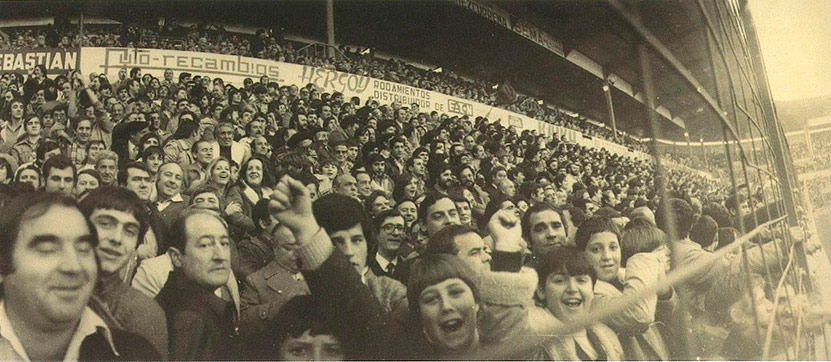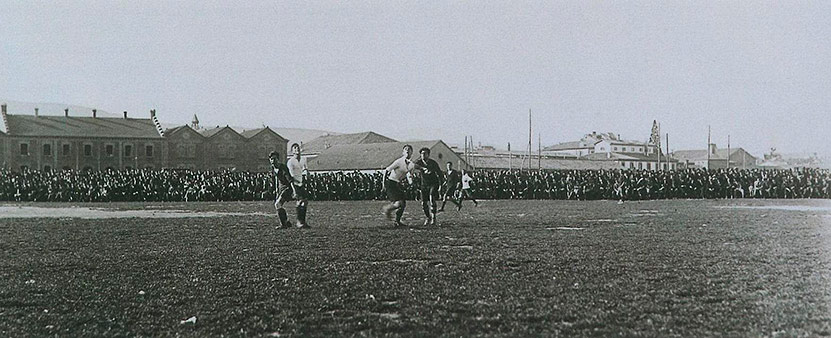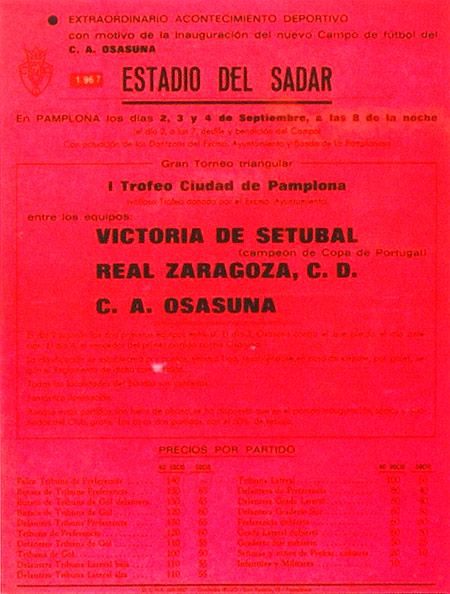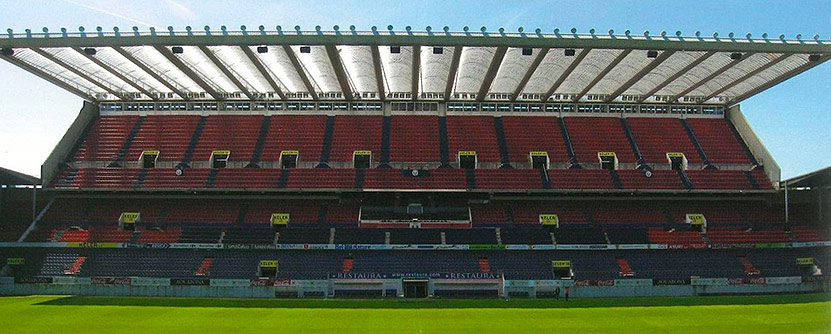Think
Osasuna, its stadium and its fans:
Intangible values of a centenary club
To celebrate the 100 years of Osasuna, Javier Azanza, Senior Associate Professor of
History of Art of the School of Philosophy and Letters of the University of Navarra,
reminds us of the history of the Club through its intangible values. A unique look
to commemorate the first centenary of a team that has managed to win the hearts of generations of red-and-blue
the hearts of generations of rojillos and rojillas.

A young Javier Azanza, in the centre of the image and with his arm raised, celebrates an Osasuna goal.
In Azanza, J. (2007). Football and architecture: stadiums, the new cathedrals of the 21st century.
|
|
"We are now a very attractive club. The context, the atmosphere of the club, the way we play, the city, the fans... all that is an added value for the club.
This accurate diagnosis by Braulio Vázquez, director sporting of Club Atlético Osasuna, on 14 September, leads me to reflect on the "intangibles", that set of factors that give a plus to a centenary club like Osasuna and which, from the very moment of its foundation, have been passed down from generation to generation, as if it were a rich intangible legacy. And among these intangibles are its stadium and its fans, a binomial in which lies a good part of the success of Osasuna in its centenary history.
Since its foundation in 1920, Osasuna became a true hallmark of Pamplona and Navarre. The stony and uneven fields of Ensanche and Hipódromo, where it played its first matches, were replaced by the Campo de San Juan, inaugurated in 1922. Its successive refurbishments transformed its appearance and raised its capacity from 4,000 to 20,000 fans, who, especially from "La Leonera", the liveliest stand under which the changing rooms were located, turned the stadium into a pressure cooker.

The Hippodrome, one of the first witnesses to the birth of Osasuna. In Azanza, J. (2007).
Football and architecture: stadiums, the new cathedrals of the 21st century.
The memory of the fans walking to the stadium after their last coffee or drink in the bars of the old town and listening to the public address system of the stadium in the distance, recalls journalist Jesús Riaño, is a picture that many of us will have heard our grandparents tell us about.
The image of those osasunistas from the middle of the last century going to San Juan had something of a processional ritual, as if it were a civil pilgrimage until they reached the football "sanctuary" to enjoy the saves of Eusebio "Palotes", the play of Ignacio Zoco and Pedro Mari Zabalza and the goals of Julián Vergara.

Match between Osasuna and Real Madrid. In Azanza, J. (2007).
Football and architecture: stadiums, the new cathedrals of the 21st century.
From San Juan to El Sadar
But times change, and with them the urban planning of our city, so the time came to close the old San Juan and to build a new stadium, El Sadar, which opened its doors on 2 September 1967 with the celebration of a triangular tournament between Zaragoza, Vitória Setúbal and Osasuna.
Its architect, Tomás Arrarás, a great fan of Osasuna and who had been responsible for the last renovation of San Juan a decade ago, designed a project that would fit in as much as possible with the spirit of a team and a fan base like those of Osasuna.
Hence he conceived a stadium Closed of subject English that largely maintained the spirit of San Juan, with stands of marked verticality and very close to the lawn so that the support of the public could be felt as strongly as possible.
Even the location of the ground itself, on the outskirts of Pamplona but not too far from the city, allows the ritual of the pilgrimage of fans to continue today, some concentrated and silent, others commenting on the line-up, analysing the weak points of their opponents or predicting the final result .

advertisement of the inauguration of the Sadar. In Azanza, J. (2007).
Football and architecture: stadiums, the new cathedrals of the 21st century.
Since then, El Sadar has undergone numerous transformations to increase its seating capacity, modernise its Structures and adapt to safety regulations: gone are the protective fences around the pitch, through which we kids who have been around for over half a century used to climb, where "Chiquilín" would climb to launch his famous battle cry, and Enrique Martín Monreal to celebrate goals with the fans. And the new Tribuna de Preferencia, testimony to the efforts of Fermín Ezcurra, an exemplary president.

The Sadar's preferential grandstand. In Azanza, J. (2007).
Football and architecture: stadiums, the new cathedrals of the 21st century.
But always without losing its true hallmarks, in that necessary communion of team and fans thanks to the proximity of the stands to the pitch, which makes it one of the most uncomfortable grounds for visiting teams. " It's an uncomfortable visit , a difficult ground where things have always been difficult for us", declared Zinedine Zidane in February 2017, recalling his time first as a player and then as Real Madrid coach.
A stadium where the decibel Issue in matches core topic is such that it carries the local player on his shoulders and generates a pressure difficult to bear on the visitor. A stadium where not only the great clubs of the national competition have bowed the knee, but also some European transatlantics in unforgettable nights for the osasunismo.
Just ask Glasgow Rangers, Stuttgart, Girondins Bordeaux or Bayer Leverkusen. And even Hamburg, although it wasn't to be, and the dream of playing in the Champions League went up in smoke on that hot night of 22 August 2006 that we will always remember.
Fifty years after its construction, El Sadar, a contemporary of other stadiums built in the 1960s such as the Vicente Calderón (Atlético de Madrid) or the Ciudad de Valencia (Levate U. D.), has been rejuvenated and dressed in a new suit to commemorate the club's centenary. But this remodelling could not leave aside the immaterial values, the intangibles of the club.
An impregnable impregnable
"What is Osasuna? Fight. Pride. What is being an Osasunista? Emotion. Courage. submission. What should El Sadar be like? Fearsome. Thundering. A wall for visitors". This is how the video presentation of Red Wall project , winner of the 2018 competition for the renovation of the stadium, designed by OFS Architects and VDR-FS Structures.
The winning project could not be clearer in its philosophy, which proposes the remodelling of El Sadar "to connect the DNA of the Osasuna fans with the spirit of the club and what it represents. The proposal maintains the essence of El Sadar, creating a thunderous, difficult and fearsome stadium. A stadium that encourages the support of the team and the pressure of the fans on the opposition, the hallmarks of Osasuna's identity". All of this, to finish by describing the stadium that has emerged from the renovation as a "real fortress".
"Fortín" has been the term employee on countless occasions to define the Osasuna stadium, one of the most recent being last February by former footballer and current sports commentator Álvaro Benito.
From the verticality, loudness and proximity of the fan to the player, El Sadar has to generate an atmosphere that contributes to push each workshop team to achieve victory, becoming an impregnable fortress.
"Everyone is looking forward to seeing the new Sadar with a sell-out crowd. The illusion is to work every week to be able to reach goal of a full Sadar, with that communion between team and fans", said Jagoba Arrasate at press conference on 18 September, at a time when the Covid-19 pandemic continues to close the stadium doors to the public. And we still don't know how long it will be before we fans will be able to listen to AC/DC'sThunderstruck again during the team's warm-up.

Osasuna shield for the centenary. (2019). source of the image.
I fully agree with the words of the coach. El Sadar is synonymous with tradition, feeling and passion, a sort of second home where the Osasunista family comes together and with their encouragement breathes life and feeling into a ground that only then acquires its plenary session of the Executive Council meaning and raison d'être.
An Osasunista family that remains loyal to its team after closing the season ticket campaign for the 20/21 season with 20,465 members, an all-time club record. A fact that has led Luis Sabalza, president of the club, to affirm that "we have the best fans in the world". And the fact is that Osasuna will never walk alone.
"El Sadar: a new version, the spirit of always. Heritage and deep-rooted tradition, passed down from generation to generation. Intangible values of a centenary club with its own signs of identity: Club Atlético Osasuna. Many congratulations to the club and its fans. May we all soon be able to enjoy the remodelled stadium together.
|
|






